Dissertation: Impact of Culture & Practices on Vodafone Performance
VerifiedAdded on 2023/06/11
|110
|23970
|227
Thesis and Dissertation
AI Summary
This dissertation investigates the impact of organizational culture and working practices on business performance through a comparative study of Vodafone in the UK and Albania. It examines the principles of a healthy organizational culture, including employee cordiality, impartiality, and recognition of top performers. The research employs a mixed-methods approach, utilizing both quantitative (surveys analyzed with SPSS) and qualitative (interviews) data collection techniques. The study reviews international human resource management and Hofstede's cultural dimensions in relation to the UK and Albania. Findings suggest that a flexible work environment fosters faster decision-making and improved customer service, benefiting business performance. Recommendations include enhancing teamwork, maintaining flexible working cultures, improving risk-taking abilities, and boosting employee motivation in both Vodafone UK and Albania.
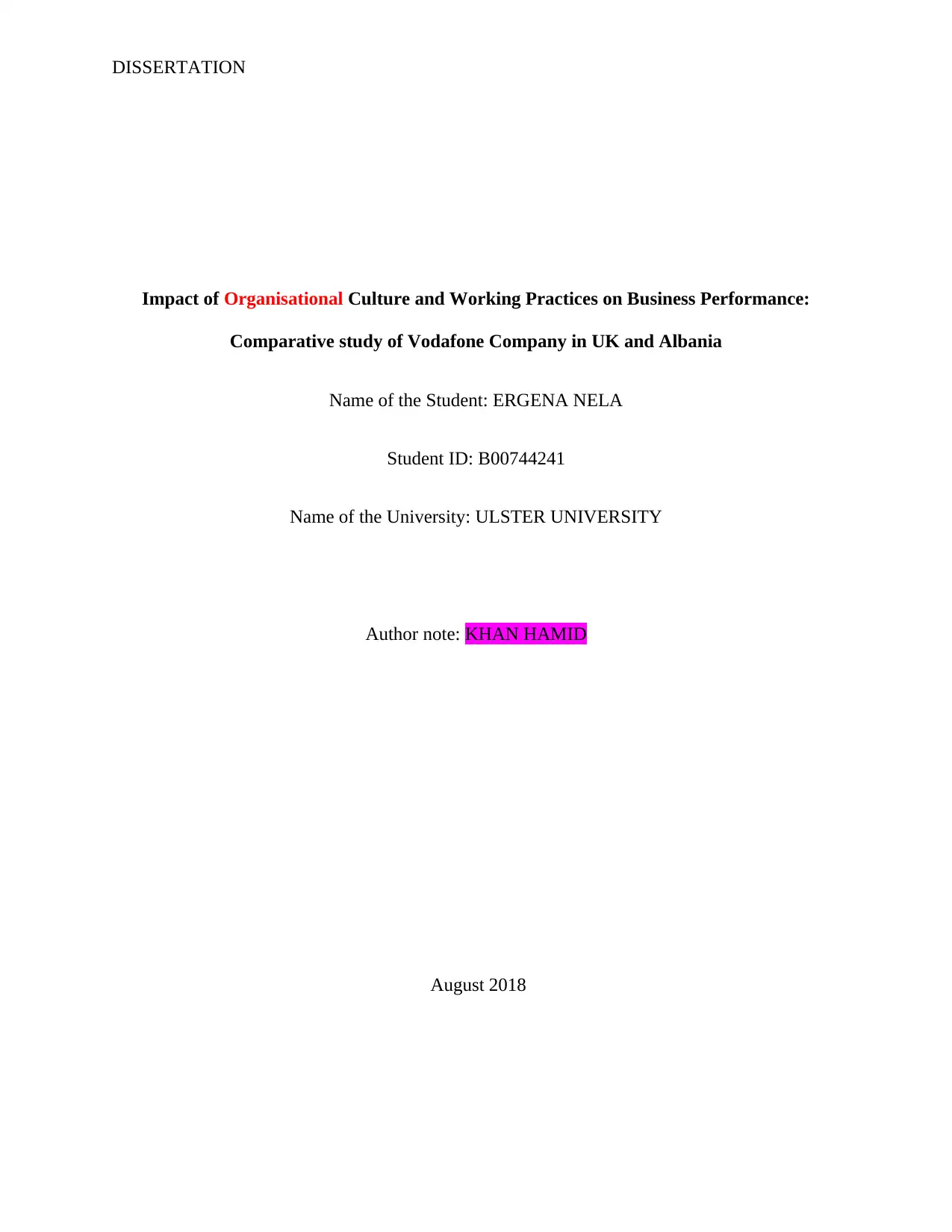
DISSERTATION
Impact of Organisational Culture and Working Practices on Business Performance:
Comparative study of Vodafone Company in UK and Albania
Name of the Student: ERGENA NELA
Student ID: B00744241
Name of the University: ULSTER UNIVERSITY
Author note: KHAN HAMID
August 2018
Impact of Organisational Culture and Working Practices on Business Performance:
Comparative study of Vodafone Company in UK and Albania
Name of the Student: ERGENA NELA
Student ID: B00744241
Name of the University: ULSTER UNIVERSITY
Author note: KHAN HAMID
August 2018
Paraphrase This Document
Need a fresh take? Get an instant paraphrase of this document with our AI Paraphraser
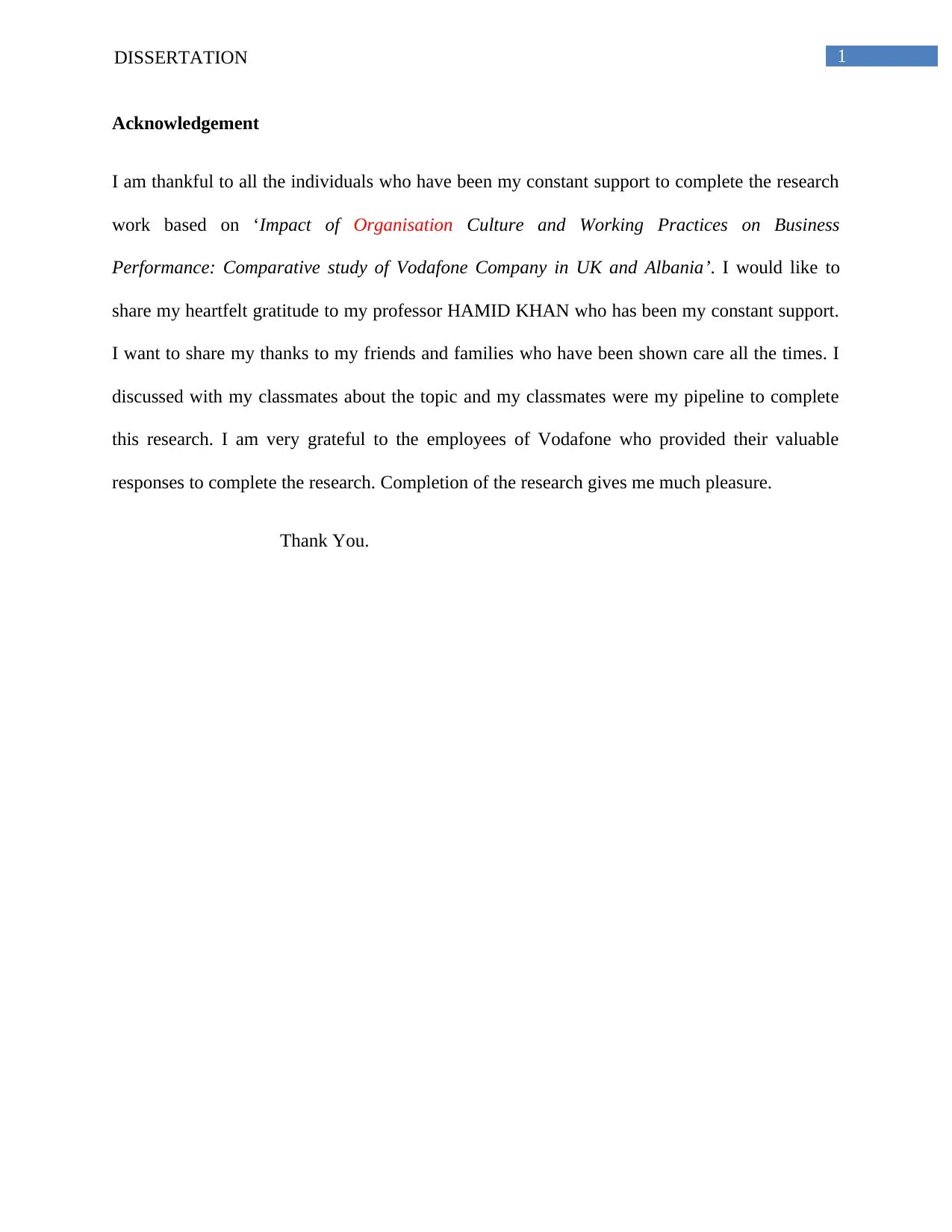
1DISSERTATION
Acknowledgement
I am thankful to all the individuals who have been my constant support to complete the research
work based on ‘Impact of Organisation Culture and Working Practices on Business
Performance: Comparative study of Vodafone Company in UK and Albania’. I would like to
share my heartfelt gratitude to my professor HAMID KHAN who has been my constant support.
I want to share my thanks to my friends and families who have been shown care all the times. I
discussed with my classmates about the topic and my classmates were my pipeline to complete
this research. I am very grateful to the employees of Vodafone who provided their valuable
responses to complete the research. Completion of the research gives me much pleasure.
Thank You.
Acknowledgement
I am thankful to all the individuals who have been my constant support to complete the research
work based on ‘Impact of Organisation Culture and Working Practices on Business
Performance: Comparative study of Vodafone Company in UK and Albania’. I would like to
share my heartfelt gratitude to my professor HAMID KHAN who has been my constant support.
I want to share my thanks to my friends and families who have been shown care all the times. I
discussed with my classmates about the topic and my classmates were my pipeline to complete
this research. I am very grateful to the employees of Vodafone who provided their valuable
responses to complete the research. Completion of the research gives me much pleasure.
Thank You.
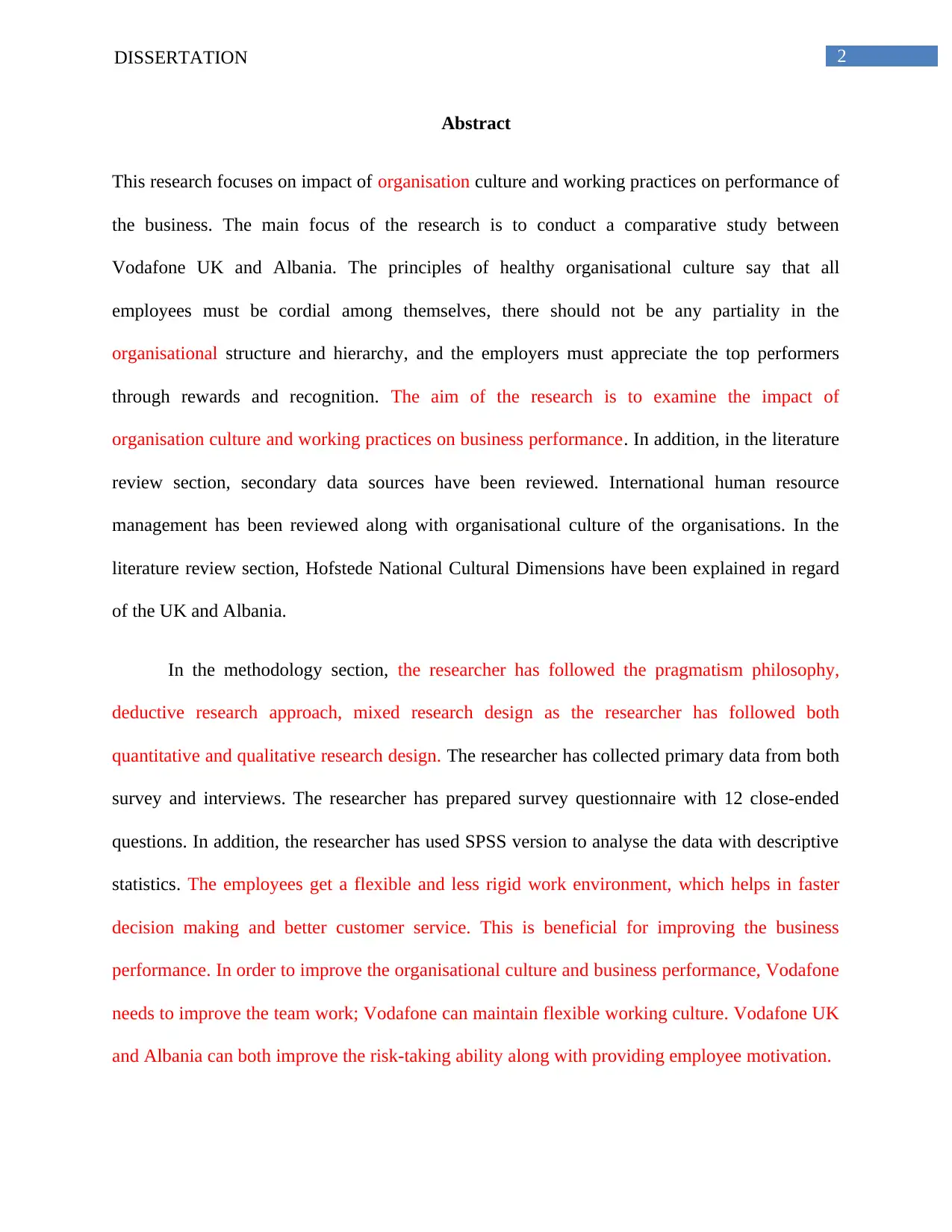
2DISSERTATION
Abstract
This research focuses on impact of organisation culture and working practices on performance of
the business. The main focus of the research is to conduct a comparative study between
Vodafone UK and Albania. The principles of healthy organisational culture say that all
employees must be cordial among themselves, there should not be any partiality in the
organisational structure and hierarchy, and the employers must appreciate the top performers
through rewards and recognition. The aim of the research is to examine the impact of
organisation culture and working practices on business performance. In addition, in the literature
review section, secondary data sources have been reviewed. International human resource
management has been reviewed along with organisational culture of the organisations. In the
literature review section, Hofstede National Cultural Dimensions have been explained in regard
of the UK and Albania.
In the methodology section, the researcher has followed the pragmatism philosophy,
deductive research approach, mixed research design as the researcher has followed both
quantitative and qualitative research design. The researcher has collected primary data from both
survey and interviews. The researcher has prepared survey questionnaire with 12 close-ended
questions. In addition, the researcher has used SPSS version to analyse the data with descriptive
statistics. The employees get a flexible and less rigid work environment, which helps in faster
decision making and better customer service. This is beneficial for improving the business
performance. In order to improve the organisational culture and business performance, Vodafone
needs to improve the team work; Vodafone can maintain flexible working culture. Vodafone UK
and Albania can both improve the risk-taking ability along with providing employee motivation.
Abstract
This research focuses on impact of organisation culture and working practices on performance of
the business. The main focus of the research is to conduct a comparative study between
Vodafone UK and Albania. The principles of healthy organisational culture say that all
employees must be cordial among themselves, there should not be any partiality in the
organisational structure and hierarchy, and the employers must appreciate the top performers
through rewards and recognition. The aim of the research is to examine the impact of
organisation culture and working practices on business performance. In addition, in the literature
review section, secondary data sources have been reviewed. International human resource
management has been reviewed along with organisational culture of the organisations. In the
literature review section, Hofstede National Cultural Dimensions have been explained in regard
of the UK and Albania.
In the methodology section, the researcher has followed the pragmatism philosophy,
deductive research approach, mixed research design as the researcher has followed both
quantitative and qualitative research design. The researcher has collected primary data from both
survey and interviews. The researcher has prepared survey questionnaire with 12 close-ended
questions. In addition, the researcher has used SPSS version to analyse the data with descriptive
statistics. The employees get a flexible and less rigid work environment, which helps in faster
decision making and better customer service. This is beneficial for improving the business
performance. In order to improve the organisational culture and business performance, Vodafone
needs to improve the team work; Vodafone can maintain flexible working culture. Vodafone UK
and Albania can both improve the risk-taking ability along with providing employee motivation.
⊘ This is a preview!⊘
Do you want full access?
Subscribe today to unlock all pages.

Trusted by 1+ million students worldwide
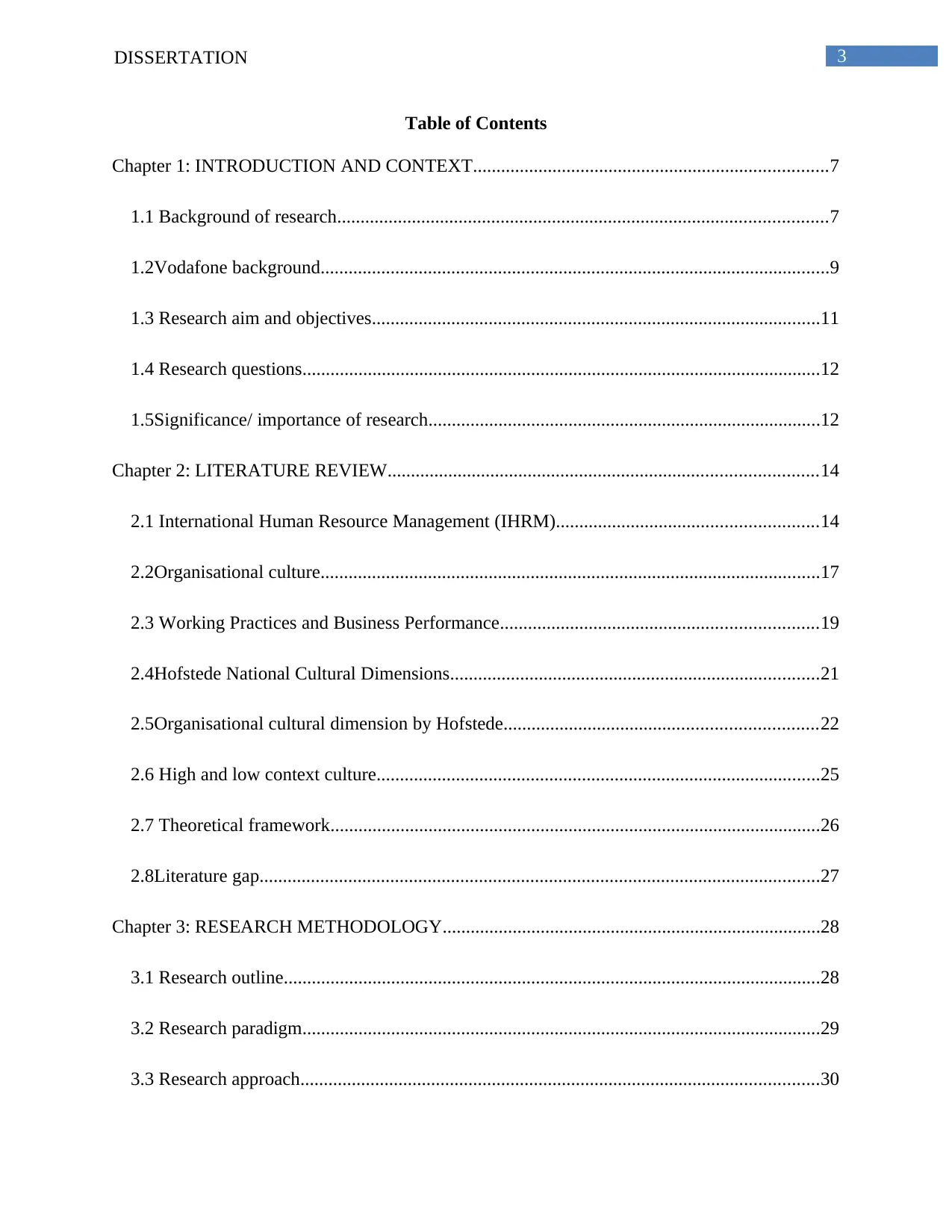
3DISSERTATION
Table of Contents
Chapter 1: INTRODUCTION AND CONTEXT............................................................................7
1.1 Background of research.........................................................................................................7
1.2Vodafone background.............................................................................................................9
1.3 Research aim and objectives................................................................................................11
1.4 Research questions...............................................................................................................12
1.5Significance/ importance of research....................................................................................12
Chapter 2: LITERATURE REVIEW............................................................................................14
2.1 International Human Resource Management (IHRM)........................................................14
2.2Organisational culture...........................................................................................................17
2.3 Working Practices and Business Performance....................................................................19
2.4Hofstede National Cultural Dimensions...............................................................................21
2.5Organisational cultural dimension by Hofstede...................................................................22
2.6 High and low context culture...............................................................................................25
2.7 Theoretical framework.........................................................................................................26
2.8Literature gap........................................................................................................................27
Chapter 3: RESEARCH METHODOLOGY.................................................................................28
3.1 Research outline...................................................................................................................28
3.2 Research paradigm...............................................................................................................29
3.3 Research approach...............................................................................................................30
Table of Contents
Chapter 1: INTRODUCTION AND CONTEXT............................................................................7
1.1 Background of research.........................................................................................................7
1.2Vodafone background.............................................................................................................9
1.3 Research aim and objectives................................................................................................11
1.4 Research questions...............................................................................................................12
1.5Significance/ importance of research....................................................................................12
Chapter 2: LITERATURE REVIEW............................................................................................14
2.1 International Human Resource Management (IHRM)........................................................14
2.2Organisational culture...........................................................................................................17
2.3 Working Practices and Business Performance....................................................................19
2.4Hofstede National Cultural Dimensions...............................................................................21
2.5Organisational cultural dimension by Hofstede...................................................................22
2.6 High and low context culture...............................................................................................25
2.7 Theoretical framework.........................................................................................................26
2.8Literature gap........................................................................................................................27
Chapter 3: RESEARCH METHODOLOGY.................................................................................28
3.1 Research outline...................................................................................................................28
3.2 Research paradigm...............................................................................................................29
3.3 Research approach...............................................................................................................30
Paraphrase This Document
Need a fresh take? Get an instant paraphrase of this document with our AI Paraphraser
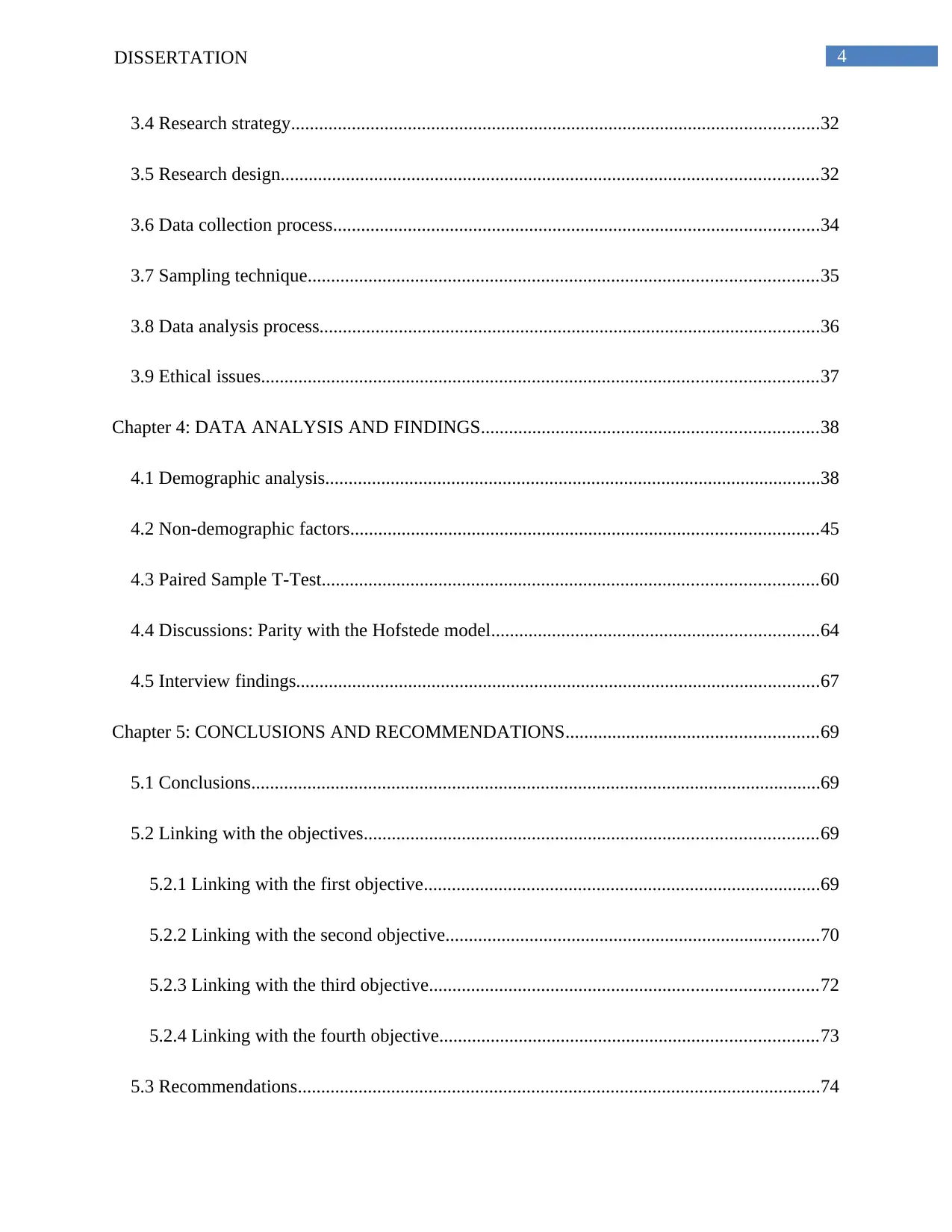
4DISSERTATION
3.4 Research strategy.................................................................................................................32
3.5 Research design...................................................................................................................32
3.6 Data collection process........................................................................................................34
3.7 Sampling technique.............................................................................................................35
3.8 Data analysis process...........................................................................................................36
3.9 Ethical issues.......................................................................................................................37
Chapter 4: DATA ANALYSIS AND FINDINGS........................................................................38
4.1 Demographic analysis..........................................................................................................38
4.2 Non-demographic factors....................................................................................................45
4.3 Paired Sample T-Test..........................................................................................................60
4.4 Discussions: Parity with the Hofstede model......................................................................64
4.5 Interview findings................................................................................................................67
Chapter 5: CONCLUSIONS AND RECOMMENDATIONS......................................................69
5.1 Conclusions..........................................................................................................................69
5.2 Linking with the objectives.................................................................................................69
5.2.1 Linking with the first objective.....................................................................................69
5.2.2 Linking with the second objective................................................................................70
5.2.3 Linking with the third objective...................................................................................72
5.2.4 Linking with the fourth objective.................................................................................73
5.3 Recommendations................................................................................................................74
3.4 Research strategy.................................................................................................................32
3.5 Research design...................................................................................................................32
3.6 Data collection process........................................................................................................34
3.7 Sampling technique.............................................................................................................35
3.8 Data analysis process...........................................................................................................36
3.9 Ethical issues.......................................................................................................................37
Chapter 4: DATA ANALYSIS AND FINDINGS........................................................................38
4.1 Demographic analysis..........................................................................................................38
4.2 Non-demographic factors....................................................................................................45
4.3 Paired Sample T-Test..........................................................................................................60
4.4 Discussions: Parity with the Hofstede model......................................................................64
4.5 Interview findings................................................................................................................67
Chapter 5: CONCLUSIONS AND RECOMMENDATIONS......................................................69
5.1 Conclusions..........................................................................................................................69
5.2 Linking with the objectives.................................................................................................69
5.2.1 Linking with the first objective.....................................................................................69
5.2.2 Linking with the second objective................................................................................70
5.2.3 Linking with the third objective...................................................................................72
5.2.4 Linking with the fourth objective.................................................................................73
5.3 Recommendations................................................................................................................74

5DISSERTATION
Reference List................................................................................................................................77
Appendices....................................................................................................................................87
Reference List................................................................................................................................77
Appendices....................................................................................................................................87
⊘ This is a preview!⊘
Do you want full access?
Subscribe today to unlock all pages.

Trusted by 1+ million students worldwide
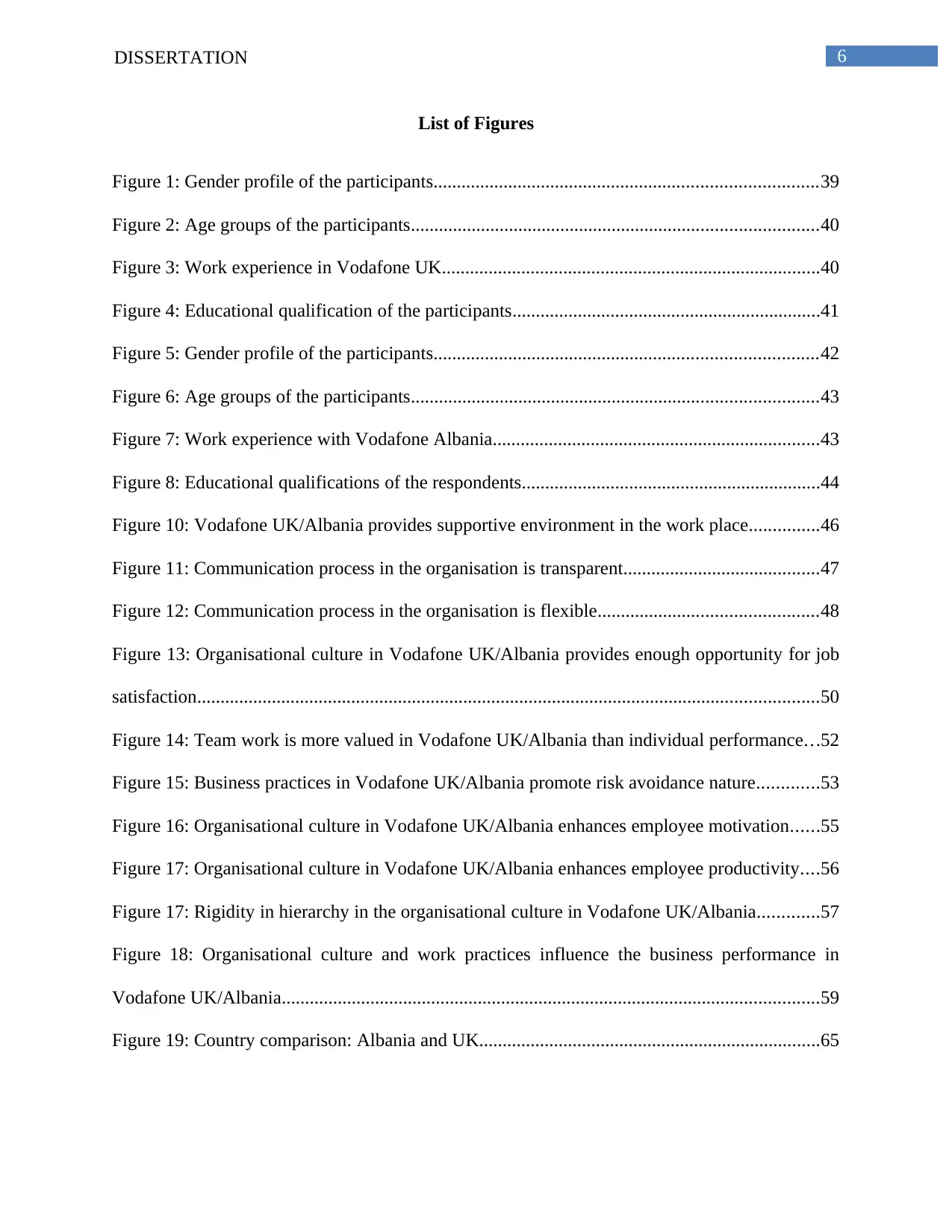
6DISSERTATION
List of Figures
Figure 1: Gender profile of the participants..................................................................................39
Figure 2: Age groups of the participants.......................................................................................40
Figure 3: Work experience in Vodafone UK.................................................................................40
Figure 4: Educational qualification of the participants..................................................................41
Figure 5: Gender profile of the participants..................................................................................42
Figure 6: Age groups of the participants.......................................................................................43
Figure 7: Work experience with Vodafone Albania......................................................................43
Figure 8: Educational qualifications of the respondents................................................................44
Figure 10: Vodafone UK/Albania provides supportive environment in the work place...............46
Figure 11: Communication process in the organisation is transparent..........................................47
Figure 12: Communication process in the organisation is flexible...............................................48
Figure 13: Organisational culture in Vodafone UK/Albania provides enough opportunity for job
satisfaction.....................................................................................................................................50
Figure 14: Team work is more valued in Vodafone UK/Albania than individual performance...52
Figure 15: Business practices in Vodafone UK/Albania promote risk avoidance nature.............53
Figure 16: Organisational culture in Vodafone UK/Albania enhances employee motivation......55
Figure 17: Organisational culture in Vodafone UK/Albania enhances employee productivity....56
Figure 17: Rigidity in hierarchy in the organisational culture in Vodafone UK/Albania.............57
Figure 18: Organisational culture and work practices influence the business performance in
Vodafone UK/Albania...................................................................................................................59
Figure 19: Country comparison: Albania and UK.........................................................................65
List of Figures
Figure 1: Gender profile of the participants..................................................................................39
Figure 2: Age groups of the participants.......................................................................................40
Figure 3: Work experience in Vodafone UK.................................................................................40
Figure 4: Educational qualification of the participants..................................................................41
Figure 5: Gender profile of the participants..................................................................................42
Figure 6: Age groups of the participants.......................................................................................43
Figure 7: Work experience with Vodafone Albania......................................................................43
Figure 8: Educational qualifications of the respondents................................................................44
Figure 10: Vodafone UK/Albania provides supportive environment in the work place...............46
Figure 11: Communication process in the organisation is transparent..........................................47
Figure 12: Communication process in the organisation is flexible...............................................48
Figure 13: Organisational culture in Vodafone UK/Albania provides enough opportunity for job
satisfaction.....................................................................................................................................50
Figure 14: Team work is more valued in Vodafone UK/Albania than individual performance...52
Figure 15: Business practices in Vodafone UK/Albania promote risk avoidance nature.............53
Figure 16: Organisational culture in Vodafone UK/Albania enhances employee motivation......55
Figure 17: Organisational culture in Vodafone UK/Albania enhances employee productivity....56
Figure 17: Rigidity in hierarchy in the organisational culture in Vodafone UK/Albania.............57
Figure 18: Organisational culture and work practices influence the business performance in
Vodafone UK/Albania...................................................................................................................59
Figure 19: Country comparison: Albania and UK.........................................................................65
Paraphrase This Document
Need a fresh take? Get an instant paraphrase of this document with our AI Paraphraser
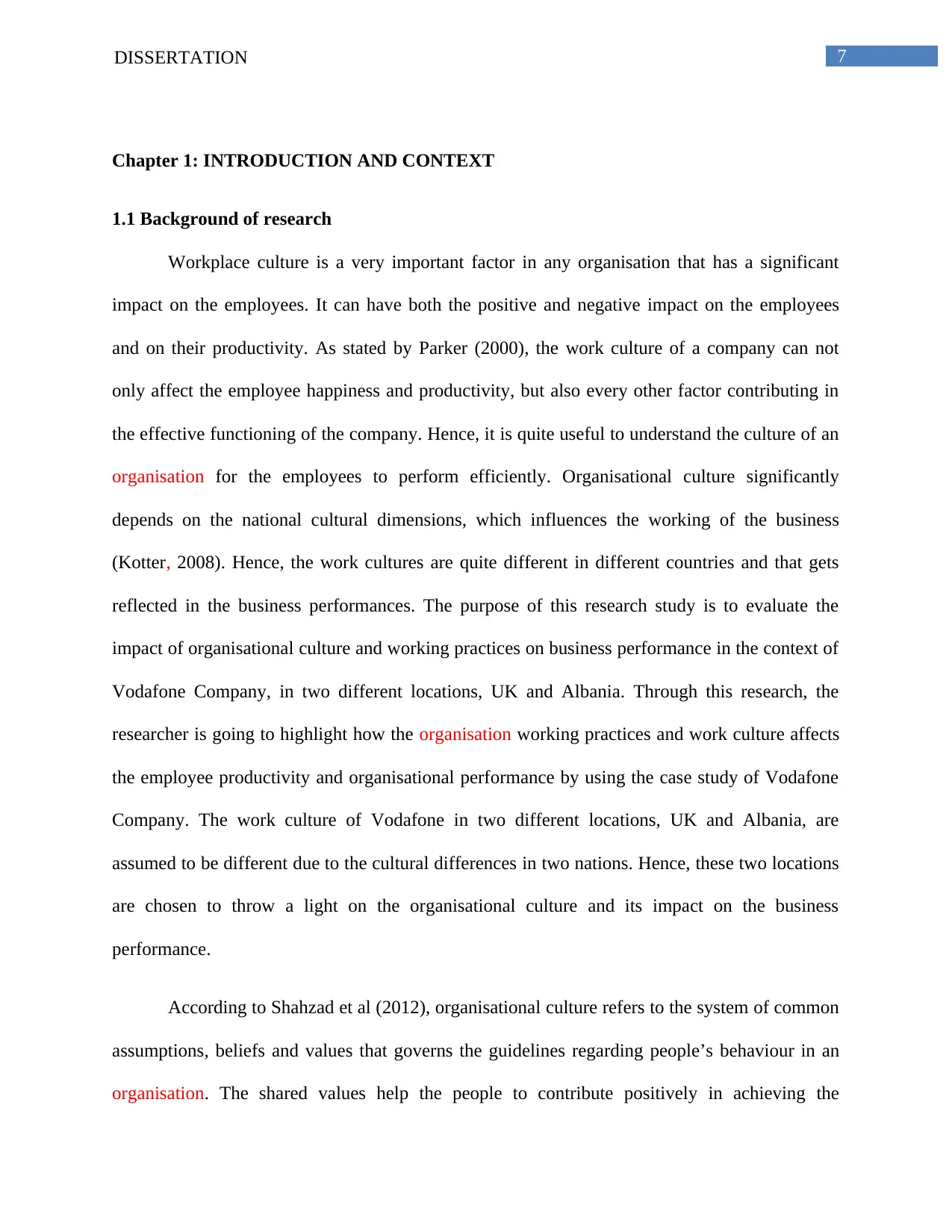
7DISSERTATION
Chapter 1: INTRODUCTION AND CONTEXT
1.1 Background of research
Workplace culture is a very important factor in any organisation that has a significant
impact on the employees. It can have both the positive and negative impact on the employees
and on their productivity. As stated by Parker (2000), the work culture of a company can not
only affect the employee happiness and productivity, but also every other factor contributing in
the effective functioning of the company. Hence, it is quite useful to understand the culture of an
organisation for the employees to perform efficiently. Organisational culture significantly
depends on the national cultural dimensions, which influences the working of the business
(Kotter, 2008). Hence, the work cultures are quite different in different countries and that gets
reflected in the business performances. The purpose of this research study is to evaluate the
impact of organisational culture and working practices on business performance in the context of
Vodafone Company, in two different locations, UK and Albania. Through this research, the
researcher is going to highlight how the organisation working practices and work culture affects
the employee productivity and organisational performance by using the case study of Vodafone
Company. The work culture of Vodafone in two different locations, UK and Albania, are
assumed to be different due to the cultural differences in two nations. Hence, these two locations
are chosen to throw a light on the organisational culture and its impact on the business
performance.
According to Shahzad et al (2012), organisational culture refers to the system of common
assumptions, beliefs and values that governs the guidelines regarding people’s behaviour in an
organisation. The shared values help the people to contribute positively in achieving the
Chapter 1: INTRODUCTION AND CONTEXT
1.1 Background of research
Workplace culture is a very important factor in any organisation that has a significant
impact on the employees. It can have both the positive and negative impact on the employees
and on their productivity. As stated by Parker (2000), the work culture of a company can not
only affect the employee happiness and productivity, but also every other factor contributing in
the effective functioning of the company. Hence, it is quite useful to understand the culture of an
organisation for the employees to perform efficiently. Organisational culture significantly
depends on the national cultural dimensions, which influences the working of the business
(Kotter, 2008). Hence, the work cultures are quite different in different countries and that gets
reflected in the business performances. The purpose of this research study is to evaluate the
impact of organisational culture and working practices on business performance in the context of
Vodafone Company, in two different locations, UK and Albania. Through this research, the
researcher is going to highlight how the organisation working practices and work culture affects
the employee productivity and organisational performance by using the case study of Vodafone
Company. The work culture of Vodafone in two different locations, UK and Albania, are
assumed to be different due to the cultural differences in two nations. Hence, these two locations
are chosen to throw a light on the organisational culture and its impact on the business
performance.
According to Shahzad et al (2012), organisational culture refers to the system of common
assumptions, beliefs and values that governs the guidelines regarding people’s behaviour in an
organisation. The shared values help the people to contribute positively in achieving the
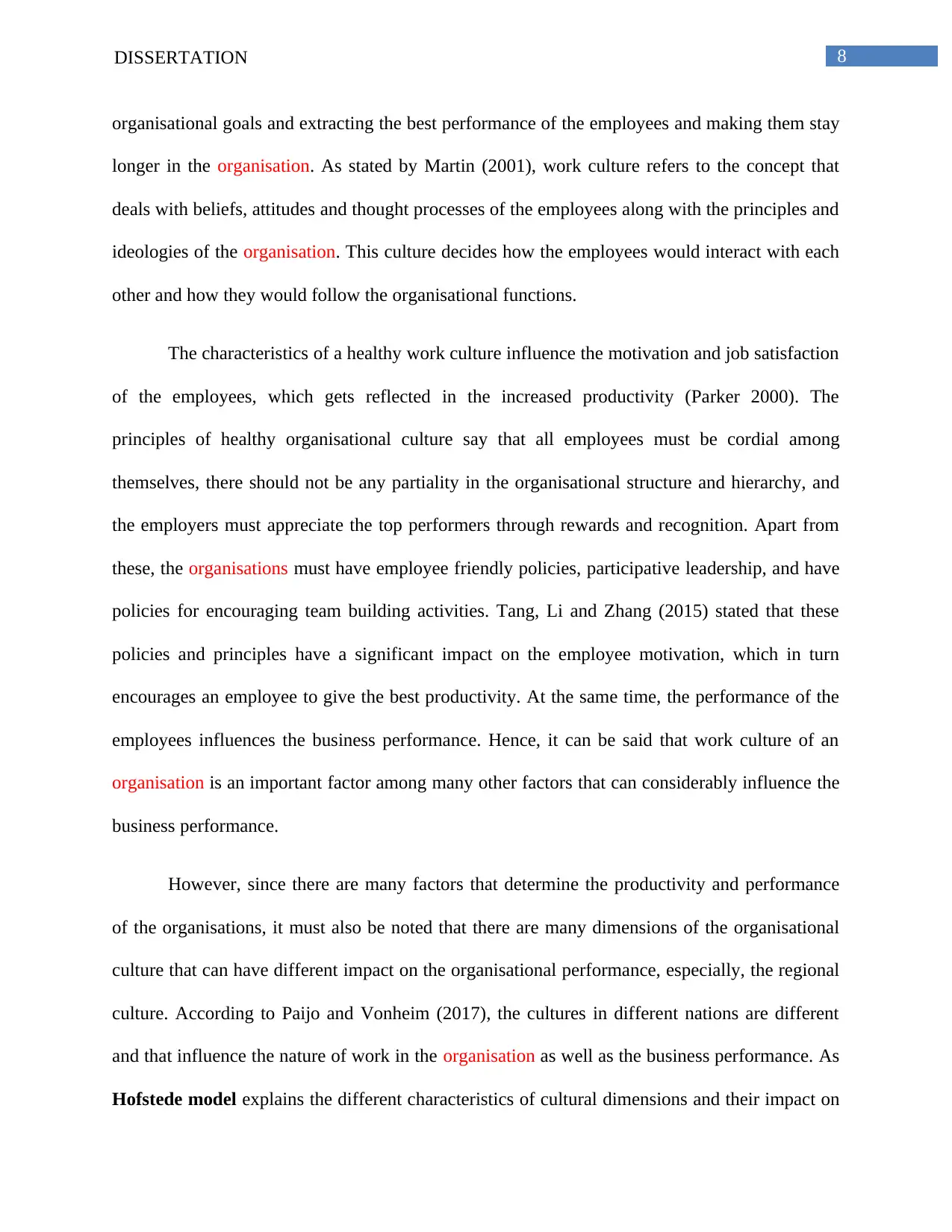
8DISSERTATION
organisational goals and extracting the best performance of the employees and making them stay
longer in the organisation. As stated by Martin (2001), work culture refers to the concept that
deals with beliefs, attitudes and thought processes of the employees along with the principles and
ideologies of the organisation. This culture decides how the employees would interact with each
other and how they would follow the organisational functions.
The characteristics of a healthy work culture influence the motivation and job satisfaction
of the employees, which gets reflected in the increased productivity (Parker 2000). The
principles of healthy organisational culture say that all employees must be cordial among
themselves, there should not be any partiality in the organisational structure and hierarchy, and
the employers must appreciate the top performers through rewards and recognition. Apart from
these, the organisations must have employee friendly policies, participative leadership, and have
policies for encouraging team building activities. Tang, Li and Zhang (2015) stated that these
policies and principles have a significant impact on the employee motivation, which in turn
encourages an employee to give the best productivity. At the same time, the performance of the
employees influences the business performance. Hence, it can be said that work culture of an
organisation is an important factor among many other factors that can considerably influence the
business performance.
However, since there are many factors that determine the productivity and performance
of the organisations, it must also be noted that there are many dimensions of the organisational
culture that can have different impact on the organisational performance, especially, the regional
culture. According to Paijo and Vonheim (2017), the cultures in different nations are different
and that influence the nature of work in the organisation as well as the business performance. As
Hofstede model explains the different characteristics of cultural dimensions and their impact on
organisational goals and extracting the best performance of the employees and making them stay
longer in the organisation. As stated by Martin (2001), work culture refers to the concept that
deals with beliefs, attitudes and thought processes of the employees along with the principles and
ideologies of the organisation. This culture decides how the employees would interact with each
other and how they would follow the organisational functions.
The characteristics of a healthy work culture influence the motivation and job satisfaction
of the employees, which gets reflected in the increased productivity (Parker 2000). The
principles of healthy organisational culture say that all employees must be cordial among
themselves, there should not be any partiality in the organisational structure and hierarchy, and
the employers must appreciate the top performers through rewards and recognition. Apart from
these, the organisations must have employee friendly policies, participative leadership, and have
policies for encouraging team building activities. Tang, Li and Zhang (2015) stated that these
policies and principles have a significant impact on the employee motivation, which in turn
encourages an employee to give the best productivity. At the same time, the performance of the
employees influences the business performance. Hence, it can be said that work culture of an
organisation is an important factor among many other factors that can considerably influence the
business performance.
However, since there are many factors that determine the productivity and performance
of the organisations, it must also be noted that there are many dimensions of the organisational
culture that can have different impact on the organisational performance, especially, the regional
culture. According to Paijo and Vonheim (2017), the cultures in different nations are different
and that influence the nature of work in the organisation as well as the business performance. As
Hofstede model explains the different characteristics of cultural dimensions and their impact on
⊘ This is a preview!⊘
Do you want full access?
Subscribe today to unlock all pages.

Trusted by 1+ million students worldwide
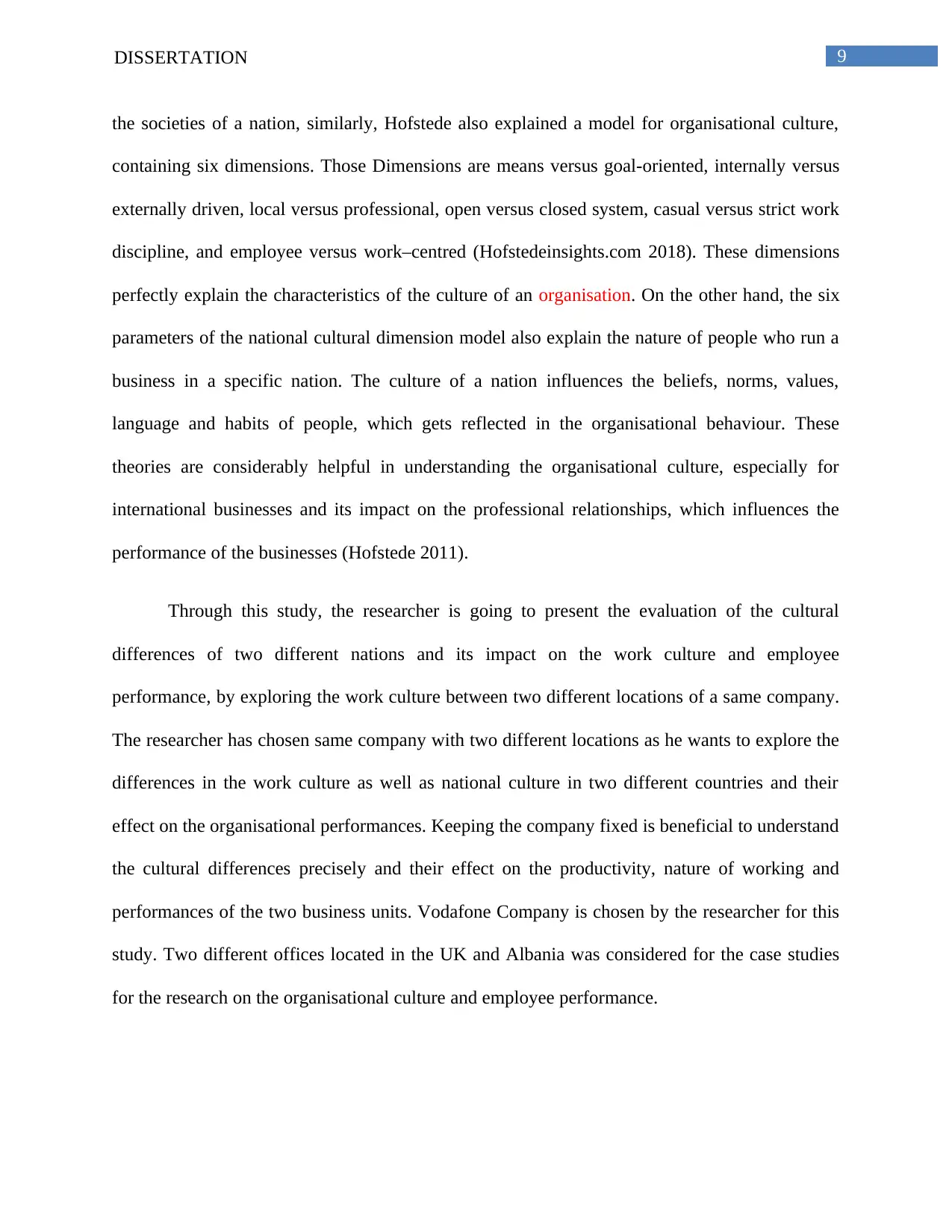
9DISSERTATION
the societies of a nation, similarly, Hofstede also explained a model for organisational culture,
containing six dimensions. Those Dimensions are means versus goal-oriented, internally versus
externally driven, local versus professional, open versus closed system, casual versus strict work
discipline, and employee versus work–centred (Hofstedeinsights.com 2018). These dimensions
perfectly explain the characteristics of the culture of an organisation. On the other hand, the six
parameters of the national cultural dimension model also explain the nature of people who run a
business in a specific nation. The culture of a nation influences the beliefs, norms, values,
language and habits of people, which gets reflected in the organisational behaviour. These
theories are considerably helpful in understanding the organisational culture, especially for
international businesses and its impact on the professional relationships, which influences the
performance of the businesses (Hofstede 2011).
Through this study, the researcher is going to present the evaluation of the cultural
differences of two different nations and its impact on the work culture and employee
performance, by exploring the work culture between two different locations of a same company.
The researcher has chosen same company with two different locations as he wants to explore the
differences in the work culture as well as national culture in two different countries and their
effect on the organisational performances. Keeping the company fixed is beneficial to understand
the cultural differences precisely and their effect on the productivity, nature of working and
performances of the two business units. Vodafone Company is chosen by the researcher for this
study. Two different offices located in the UK and Albania was considered for the case studies
for the research on the organisational culture and employee performance.
the societies of a nation, similarly, Hofstede also explained a model for organisational culture,
containing six dimensions. Those Dimensions are means versus goal-oriented, internally versus
externally driven, local versus professional, open versus closed system, casual versus strict work
discipline, and employee versus work–centred (Hofstedeinsights.com 2018). These dimensions
perfectly explain the characteristics of the culture of an organisation. On the other hand, the six
parameters of the national cultural dimension model also explain the nature of people who run a
business in a specific nation. The culture of a nation influences the beliefs, norms, values,
language and habits of people, which gets reflected in the organisational behaviour. These
theories are considerably helpful in understanding the organisational culture, especially for
international businesses and its impact on the professional relationships, which influences the
performance of the businesses (Hofstede 2011).
Through this study, the researcher is going to present the evaluation of the cultural
differences of two different nations and its impact on the work culture and employee
performance, by exploring the work culture between two different locations of a same company.
The researcher has chosen same company with two different locations as he wants to explore the
differences in the work culture as well as national culture in two different countries and their
effect on the organisational performances. Keeping the company fixed is beneficial to understand
the cultural differences precisely and their effect on the productivity, nature of working and
performances of the two business units. Vodafone Company is chosen by the researcher for this
study. Two different offices located in the UK and Albania was considered for the case studies
for the research on the organisational culture and employee performance.
Paraphrase This Document
Need a fresh take? Get an instant paraphrase of this document with our AI Paraphraser
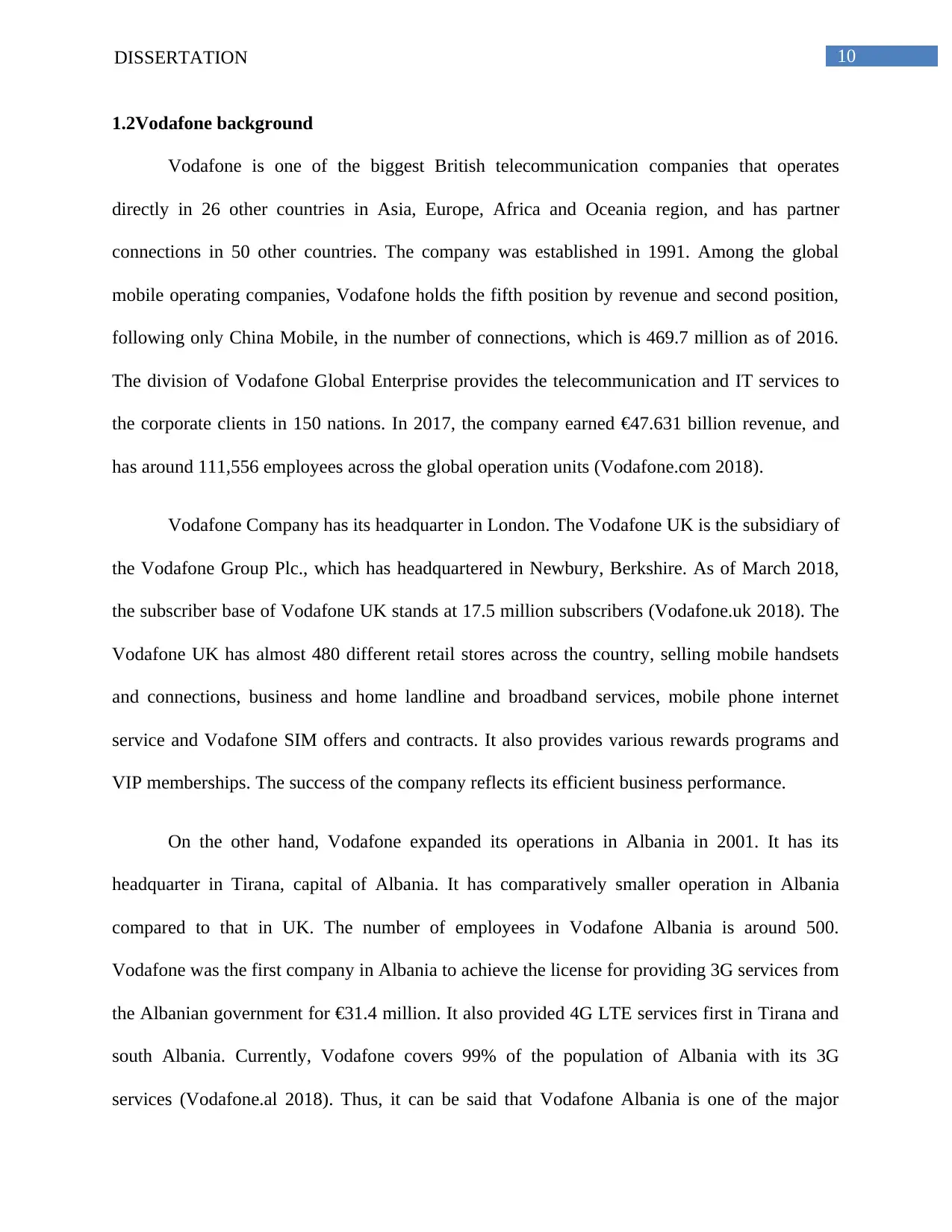
10DISSERTATION
1.2Vodafone background
Vodafone is one of the biggest British telecommunication companies that operates
directly in 26 other countries in Asia, Europe, Africa and Oceania region, and has partner
connections in 50 other countries. The company was established in 1991. Among the global
mobile operating companies, Vodafone holds the fifth position by revenue and second position,
following only China Mobile, in the number of connections, which is 469.7 million as of 2016.
The division of Vodafone Global Enterprise provides the telecommunication and IT services to
the corporate clients in 150 nations. In 2017, the company earned €47.631 billion revenue, and
has around 111,556 employees across the global operation units (Vodafone.com 2018).
Vodafone Company has its headquarter in London. The Vodafone UK is the subsidiary of
the Vodafone Group Plc., which has headquartered in Newbury, Berkshire. As of March 2018,
the subscriber base of Vodafone UK stands at 17.5 million subscribers (Vodafone.uk 2018). The
Vodafone UK has almost 480 different retail stores across the country, selling mobile handsets
and connections, business and home landline and broadband services, mobile phone internet
service and Vodafone SIM offers and contracts. It also provides various rewards programs and
VIP memberships. The success of the company reflects its efficient business performance.
On the other hand, Vodafone expanded its operations in Albania in 2001. It has its
headquarter in Tirana, capital of Albania. It has comparatively smaller operation in Albania
compared to that in UK. The number of employees in Vodafone Albania is around 500.
Vodafone was the first company in Albania to achieve the license for providing 3G services from
the Albanian government for €31.4 million. It also provided 4G LTE services first in Tirana and
south Albania. Currently, Vodafone covers 99% of the population of Albania with its 3G
services (Vodafone.al 2018). Thus, it can be said that Vodafone Albania is one of the major
1.2Vodafone background
Vodafone is one of the biggest British telecommunication companies that operates
directly in 26 other countries in Asia, Europe, Africa and Oceania region, and has partner
connections in 50 other countries. The company was established in 1991. Among the global
mobile operating companies, Vodafone holds the fifth position by revenue and second position,
following only China Mobile, in the number of connections, which is 469.7 million as of 2016.
The division of Vodafone Global Enterprise provides the telecommunication and IT services to
the corporate clients in 150 nations. In 2017, the company earned €47.631 billion revenue, and
has around 111,556 employees across the global operation units (Vodafone.com 2018).
Vodafone Company has its headquarter in London. The Vodafone UK is the subsidiary of
the Vodafone Group Plc., which has headquartered in Newbury, Berkshire. As of March 2018,
the subscriber base of Vodafone UK stands at 17.5 million subscribers (Vodafone.uk 2018). The
Vodafone UK has almost 480 different retail stores across the country, selling mobile handsets
and connections, business and home landline and broadband services, mobile phone internet
service and Vodafone SIM offers and contracts. It also provides various rewards programs and
VIP memberships. The success of the company reflects its efficient business performance.
On the other hand, Vodafone expanded its operations in Albania in 2001. It has its
headquarter in Tirana, capital of Albania. It has comparatively smaller operation in Albania
compared to that in UK. The number of employees in Vodafone Albania is around 500.
Vodafone was the first company in Albania to achieve the license for providing 3G services from
the Albanian government for €31.4 million. It also provided 4G LTE services first in Tirana and
south Albania. Currently, Vodafone covers 99% of the population of Albania with its 3G
services (Vodafone.al 2018). Thus, it can be said that Vodafone Albania is one of the major
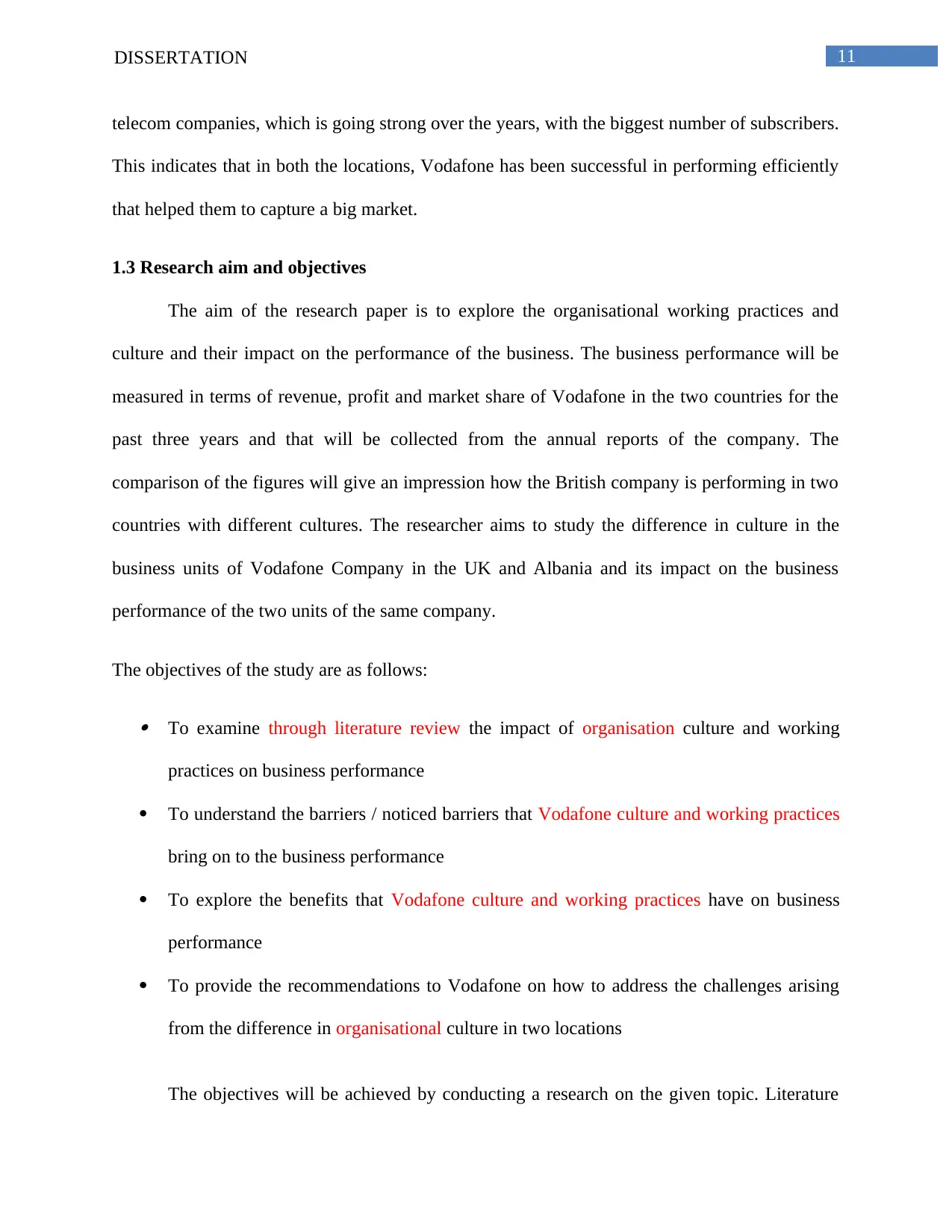
11DISSERTATION
telecom companies, which is going strong over the years, with the biggest number of subscribers.
This indicates that in both the locations, Vodafone has been successful in performing efficiently
that helped them to capture a big market.
1.3 Research aim and objectives
The aim of the research paper is to explore the organisational working practices and
culture and their impact on the performance of the business. The business performance will be
measured in terms of revenue, profit and market share of Vodafone in the two countries for the
past three years and that will be collected from the annual reports of the company. The
comparison of the figures will give an impression how the British company is performing in two
countries with different cultures. The researcher aims to study the difference in culture in the
business units of Vodafone Company in the UK and Albania and its impact on the business
performance of the two units of the same company.
The objectives of the study are as follows:
To examine through literature review the impact of organisation culture and working
practices on business performance
To understand the barriers / noticed barriers that Vodafone culture and working practices
bring on to the business performance
To explore the benefits that Vodafone culture and working practices have on business
performance
To provide the recommendations to Vodafone on how to address the challenges arising
from the difference in organisational culture in two locations
The objectives will be achieved by conducting a research on the given topic. Literature
telecom companies, which is going strong over the years, with the biggest number of subscribers.
This indicates that in both the locations, Vodafone has been successful in performing efficiently
that helped them to capture a big market.
1.3 Research aim and objectives
The aim of the research paper is to explore the organisational working practices and
culture and their impact on the performance of the business. The business performance will be
measured in terms of revenue, profit and market share of Vodafone in the two countries for the
past three years and that will be collected from the annual reports of the company. The
comparison of the figures will give an impression how the British company is performing in two
countries with different cultures. The researcher aims to study the difference in culture in the
business units of Vodafone Company in the UK and Albania and its impact on the business
performance of the two units of the same company.
The objectives of the study are as follows:
To examine through literature review the impact of organisation culture and working
practices on business performance
To understand the barriers / noticed barriers that Vodafone culture and working practices
bring on to the business performance
To explore the benefits that Vodafone culture and working practices have on business
performance
To provide the recommendations to Vodafone on how to address the challenges arising
from the difference in organisational culture in two locations
The objectives will be achieved by conducting a research on the given topic. Literature
⊘ This is a preview!⊘
Do you want full access?
Subscribe today to unlock all pages.

Trusted by 1+ million students worldwide
1 out of 110
Related Documents
Your All-in-One AI-Powered Toolkit for Academic Success.
+13062052269
info@desklib.com
Available 24*7 on WhatsApp / Email
![[object Object]](/_next/static/media/star-bottom.7253800d.svg)
Unlock your academic potential
Copyright © 2020–2025 A2Z Services. All Rights Reserved. Developed and managed by ZUCOL.





